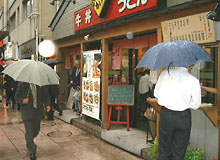FAST, CHEAP, AND SUDDENLY CHIC:
Home-Grown Fast Food Steps Into the Mainstream
September 11, 2000
|
 |
|
Lunch time is a busy hour for this gyudon outlet, which is located in a bustling business district.
|
Fast food in Japan has generally catered to the busy set: people between appointments, late for a concert, or in search of a quick bite. The premium on speed has come at the expense of variety, though, as imported versions offer either hamburger and fries or fried chicken, while indigenous varieties offer a bowl of noodles or rice. Recently, however, people on the go have been able to choose from a much broader range of speedy victuals, including Japanese, Chinese, and Western dishes, as well as ethnic dishes from across Asia.
Expanding Clientele
The expanded menu has largely been found at the home-grown outlets. The traditional image of noodle stands and other such shops has been lowbrow, occupying a fringe position far from the fashion forefront. Some have only a counter and no seats. Those slurping down their noodles or scoffing their gyudon (beef-and-onion stew on a bowl of rice) tend to be corporate foot soldiers on a brief break or students and blue-collar workers scraping by on a budget.
Young women rarely ventured into these shops--until quite recently. The reason for the transformation has to do with efforts by the fast-food chains to make the outlets more appealing to the fashion- and health-conscious. They have brightened up their decor and created roomier seating. Some have also moved the vending machines selling meal coupons inside the store, sparing women the embarrassment of buying the coupons under the gaze of passersby.
The shops have also introduced a broader, better-balanced selection of dishes that will satisfy women and families--not just time-pressed male workers. One suburban gyudon chain offers traditional boiled-vegetable and tofu dishes as well as a type of miso soup full of healthy ingredients. It appeals to children not only with kid-sized portions of favorites like curry and rice but also with free giveaways, changing souvenirs every month.
Another gyudon chain has begun offering set meals centered on a nourishing soup of grated tofu, taro potatoes, and daikon (Japanese radish) for people who want more than just slices of beef on top of rice. And a chain of noodle shops serves miniature portions of oyako-don (chicken, onion, and egg on a bowl of rice) and kakiage-don (vegetable tempura on rice) along with udon noodles to entice women diners who are more interested in variety than volume.
Intensifying Competition
Other chains have introduced their own innovations, like combinations platters, a choice of sizes, and organically grown ingredients. These efforts have paid off, and the outlets are increasingly being patronized by women, couples, and families. Sales for the most part are growing steadily, moreover, unlike many of the family restaurant chains that are seeing their sales decline.
This does not necessarily ensure a rosy future for the home-grown fast food, however. Japan's (and the world's) largest hamburger chain, for instance, has launched a price war, slashing prices in half on weekdays. Because Japanese fast food is invariably served in ceramic bowls and on plates, they must be washed, a process that eats into the shops' earnings, as does the extra time it takes to serve the food. Unless they can find ways of keeping costs to a minimum, indigenous fast-food businesses could wind up being priced out of competition.
Back to Main Index
 Copyright (c) 2000 Japan Information Network. Edited by Japan Echo Inc. based on domestic Japanese news sources. Articles presented here are offered for reference purposes and do not necessarily represent the policy or views of the Japanese Government. Copyright (c) 2000 Japan Information Network. Edited by Japan Echo Inc. based on domestic Japanese news sources. Articles presented here are offered for reference purposes and do not necessarily represent the policy or views of the Japanese Government.
|



















